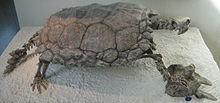Archelosauria
| Archelosauria | |
|---|---|

| |
| Proganochelys quenstedti | |
| Scientific classification | |
| Domain: | Eukaryota |
| Kingdom: | Animalia |
| Phylum: | Chordata |
| Class: | Reptilia |
| Clade: | Sauria |
| Clade: | Archelosauria Crawford et al., 2015 [1] |
| Extant Subclades | |
Archelosauria is a clade grouping turtles and archosaurs (birds and crocodilians) and their fossil relatives.[1] Multiple sequence alignments of DNA and protein sequences and phylogenetic inferences showed that chelonians are the sister group to birds and crocodilians.[2][3][4] Morever, there are about 1000 ultra-conserved elements in their genome that are unique to turtles and archosaurs, but which are not found in lepidosaurs (tuatara, lizards and snakes).[5] Other genome-wide analysis also supports this grouping.[6][7]
Etymology
The clade name Archelosauria was coined in 2015 to evoke its two subclades, the Archosauria and the Chelonia.[1]
Classification
Archelosauria is a group used to unite archosaurs with turtles. It was found that Archelosauria was grouped within Sauria, as the sister branch to lizards and Sphenodon. Below is the phylogeny from Crawford et al., showing interrelationships of Testudines at family level down to Durocryptodira.[1]
See also
- Ankylopoda, an alternative clade that places turtles as sister taxon to lepidosaurs.
References
- ^ a b c d Crawford, Nicholas G.; Parham, James F.; Sellas, Anna B.; Faircloth, Brant C.; Glenn, Travis C.; Papenfuss, Theodore J.; Henderson, James B.; Hansen, Madison H.; Simison, W. Brian (2015-02-01). "A phylogenomic analysis of turtles". Molecular Phylogenetics and Evolution. 83: 250–257. doi:10.1016/j.ympev.2014.10.021. ISSN 1055-7903. PMID 25450099.
- ^ Shen, X.-X.; Liang, D.; Wen, J.-Z.; Zhang, P. (2011-12-01). "Multiple Genome Alignments Facilitate Development of NPCL Markers: A Case Study of Tetrapod Phylogeny Focusing on the Position of Turtles". Molecular Biology and Evolution. 28 (12): 3237–3252. doi:10.1093/molbev/msr148. ISSN 0737-4038. PMID 21680872.
- ^ Tzika, Athanasia C; Helaers, Raphaël; Schramm, Gerrit; Milinkovitch, Michel C (2011). "Reptilian-transcriptome v1.0, a glimpse in the brain transcriptome of five divergent Sauropsida lineages and the phylogenetic position of turtles". EvoDevo. 2 (1): 19. doi:10.1186/2041-9139-2-19. ISSN 2041-9139. PMC 3192992. PMID 21943375.
{{cite journal}}: CS1 maint: unflagged free DOI (link) - ^ Chiari, Ylenia; Cahais, Vincent; Galtier, Nicolas; Delsuc, Frédéric (2012). "Phylogenomic analyses support the position of turtles as the sister group of birds and crocodiles (Archosauria)". BMC Biology. 10 (1): 65. doi:10.1186/1741-7007-10-65. ISSN 1741-7007. PMC 3473239. PMID 22839781.
{{cite journal}}: CS1 maint: unflagged free DOI (link) - ^ Crawford, Nicholas G.; Faircloth, Brant C.; McCormack, John E.; Brumfield, Robb T.; Winker, Kevin; Glenn, Travis C. (2012-10-23). "More than 1000 ultraconserved elements provide evidence that turtles are the sister group of archosaurs". Biology Letters. 8 (5): 783–786. doi:10.1098/rsbl.2012.0331. PMC 3440978. PMID 22593086.
- ^ Wang, Zhuo (27 March 2013). "The draft genomes of soft-shell turtle and green sea turtle yield insights into the development and evolution of the turtle-specific body plan". Nature Genetics. 45 (701–706): 701–6. doi:10.1038/ng.2615. PMC 4000948. PMID 23624526.
- ^ Field, Daniel J.; Gauthier, Jacques A.; King, Benjamin L.; Pisani, Davide; Lyson, Tyler; Peterson, Kevin J. (July–August 2014). "Toward consilience in reptile phylogeny: miRNAs support an archosaur, not lepidosaur, affinity for turtles" (PDF). Evolution & Development. 16 (4): 189–196. doi:10.1111/ede.12081. PMC 4215941. PMID 24798503. Retrieved 5 July 2015.



